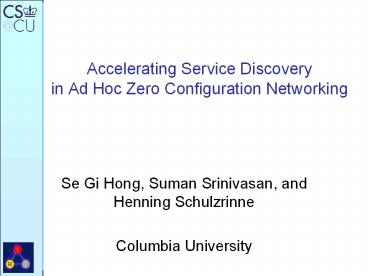Accelerating Service Discovery in Ad Hoc Zero Configuration Networking - PowerPoint PPT Presentation
1 / 18
Title:
Accelerating Service Discovery in Ad Hoc Zero Configuration Networking
Description:
in Ad Hoc Zero Configuration Networking Se Gi Hong, Suman Srinivasan, and Henning Schulzrinne Columbia University ... – PowerPoint PPT presentation
Number of Views:171
Avg rating:3.0/5.0
Title: Accelerating Service Discovery in Ad Hoc Zero Configuration Networking
1
Accelerating Service Discovery in Ad Hoc Zero
Configuration Networking
- Se Gi Hong, Suman Srinivasan, and Henning
Schulzrinne - Columbia University
2
Contents
- Wireless mobile ad-hoc networks
- Overview of Zeroconf (Zero Configuration
Networking) - Zeroconf in Mobile Ad Hoc Networks
- Analysis of the mean service loss probability
- Overview of joining process in 802.11
- Accelerating Zeroconf
- Implementation and performance
3
wireless mobile ad-hoc networks
- No Infrastructure
- Allocate IP addresses without a DHCP server
- Translate between domain names and IP addresses
without a DNS Server - Find service without a directory service
- Service discovery
- The usage of service discovery has been
increasing - e.g., iTunes (Apples music file sharing), iChat
- Solution
- Zeroconf (Zero Configuration Networking)
4
What is Zeroconf?
- IETF Zero Configuration Networking (Zeroconf) WG
- 4 requirements
- IP interface configuration
- Auto-configuration of IPv4 link-local address
without a central server (DHCP server) within the
169.254/16 subnet - Translation between host name and IP address
- Auto-configuration of a host name without a
central server (DNS server) - IP multicast address allocation
- Range of IP multicast 224.0.0.0 to
239.255.255.255 - Service discovery
- Implementation
- Bonjour
- Apples implementation of zero-configuration
networking - iTunes, iChat
- Avahi
- Open source for Linux
5
What is Zeroconf?
- Service discovery
- Users can discover available service instances of
a service types. - Bonjour
- Multicast DNS-Based service discovery (mDNS-SD)
- PTR, SRV and TXT records
- PTR lookup ltService typegt.ltDomaingt
- SRV records port number, host name
- TXT records additional information
6
What is Zeroconf?
- Service discovery
SRV 0 0 3689 segihong.local. TXT
txtvers1 segihong.local. A 169.254.153.82
MDNS standard query _daap._tcp.local. PTR?
segi._daap._tcp.local. SRV? segi._daap._tcp.local.
TXT?
MDNS standard query response PTR segi._daap._tcp.
local.
MDNS standard query response PTR suman._daap._tcp
.local.
7
Zeroconf in Mobile Ad Hoc Networks
- High mobile environment frequently join/leave
for a short time - Zeroconf does not include algorithm to detect
network topology changes - To discovery services, services should be
announced and looked up frequently -gt overhead
8
Analysis of the mean service loss probability
- Assumption
- Node arrival rate to a local ad-hoc area follows
an exponential distribution with rate ? - Node residence time follows exponential
distribution with rate ? - Service announcing and browsing interval follows
exponential distribution with rate ? - Current number of nodes in an area is n
Service browsing of node k
Service browsing of node i
T
Time
X
Node A arrives
Node As next Service announcing
Y
Node A leaves
9
Analysis of the mean service loss probability
- The service loss probability
- The mean service loss probability
10
Analysis of the mean service loss probability
Mean service loss probability
Mean service loss probability
Average number of users
Average number of users
(a) Average residence time is 60 minutes
(b) Average residence time is 10 minutes
11
What do we need?
- Current Service Discovery of Zeroconf is not
enough for high mobile environment since Zeroconf
does not have the algorithm for detecting network
topology changes - We need a method to recognize new peers
(services) in real-time while reducing overhead. - Solution
- We can use the existing Beacon frames of 802.11
12
What happens when a device joins in a local
ad-hoc network?
- Ad-hoc network
- BSSID (Basic service set identification) is
required for communication each other. - TSF (Time Synchronization Function) keeps the
timer for all node in same BSS for beacon
period. - BSSID and TSF timer value are same for all nodes
in the same BSS (Basic Service Set) - Beacon frames contains BSSID and TSF timer value
- How to join in the group?
- Initially, each device randomly chooses BSSID
- Sending probe request and scanning (listening)
Beacon frames in all channels - Adopt the information, such as BSSID and the TSF
timer, only if the SSID is matched and the value
of timestamp in the received beacon frames or
probe requests is later than the nodes TSF timer
13
What happens when a device joins in a local
ad-hoc network?
- Node A joins
BSS2
BSS1
Node A
Node B
Node C
802.11 MAC/PHY
BSSID 02022D0D6B0E TSF timer 1000
BSSID 00350E3S5D5E TSF timer 2000
14
What happens when a device joins in a local
ad-hoc network?
- Node A joins
15
Accelerating Zeroconf
- Monitoring current BSSID
- Changes of BSSID means that it joins in a new
local ad-hoc network. - If (old_BSSID ! current_BSSID), then re-trigger
service discovery. - Standard wireless extensions in Linux
- ioctl() SIOCGIWAP option get BSSID
- Windows WLAN API
- WlanGetNetworkBssList()
16
Accelerating Zeroconf
- Accelerating service discovery architecture
User A
User B
Zeroconf Software
Zeroconf Software
Application Layer
IP assign Naming Service Discovery
Monitoring BSSID
IP assign Naming Service Discovery
Monitoring BSSID
Beacon Frames
Data Link Layer
Beacon Frames
17
Performance
- Scenarios
- Three laptops (A, B, and C)
- Laptop A joins a local ad-hoc networks
- Laptop A announces a service and B and C browse
for the service - Compare to theoretical analysis of delay in
Zeroconf with periodic service announcing and
browsing - Service announcing and browsing interval
exponential distribution with rate - D is the delay
- is the next announcing or
browsing time of A, B and C - Mean of the delay is
18
Performance
- Delay measurement of the service discovery
protocol































